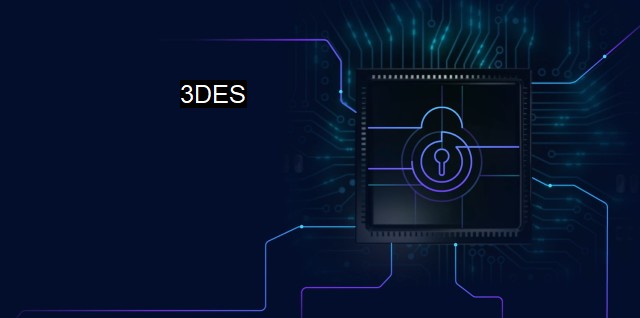What is 3DES?
How Triple DES (3DES) provides improved cybersecurity in communications-encryption and antivirus: An in-depth analysis
3DES, which stands for Triple Data Encryption Standard, is a type of symmetric-key encryption that is widely used in the cybersecurity industry. Symmetric encryption essentially means that the same key is used for both encryption and decryption processes. Designed to supersede its predecessor, the Data Encryption Standard (DES), while maintaining backwards compatibility, 3DES, despite several years into its deployment, continues to be a secure and robust method of encryption that is highly-valued in numerous security domains, including antivirus systems.Originally developed in the early 1970s, the aim of DES was to produce a standard cryptographic tool that could secure sensitive government information. The DES operates on 56-bit keys and employs a block-cipher method in which it encrypts data in 64-bit blocks. with the advent of advanced computational powers, DES was considered to no longer offer adequate protection due to vulnerabilities linked to its relatively short cryptographic key length.
Consequently, to combat these limitations and continue using DES safely, the notion of 3DES emerged. it applies the DES algorithm three consecutive times on the data block. Encrypted with one key, then decrypted with a second key, and finally encrypted once again with a third key, the triple-layered application of DES to the data increases the key length to 112 or 168 bits, largely overcoming the primary flaw experienced within the original DES model.
It is important to clarify that 3DES doesn’t mean that individual bits are encrypted thrice over, instead whole data blocks are processed for three times the effect and thus substantially increased security. This approach furthers resistance against common cracking attempts including, the brute force method. As more alternatives ensue, 3D algorithms still find mention for certain applications in secure messaging, online transactions, and antivirus methodologies.
Within antivirus systems, the expansive key size proved instrumental for maintaining data integrity and securing confidential information. Many types of antivirus and cybersecurity system used (and still use) 3DES as a default encryption method by which sensitive user information was shielded from any potential threats/beaches. Algorithmic rigidity made difficult for criminals to intercept and unlock highly-secure encrypted files.
In some cases, variations of 3DES have been developed. Known as 2-key 3DES, they primarily use two 56-bit cryptographic keys instead of three, theoretically generating 112-bit key security. Though practically owing to enormity against meet-in-the-middle attacks significant security is apprehended resulting in approximately about 80-bits of protection. The advantage of the method pertains to operating in environments requiring less computational resources or allowing reduced encryption times.
Despite assurances, critics led migration towards more secure alternates is gaining pace across institutions environment for 3DES deprecation. Issues like sweet32 birthday attacks terrifying many, concerns of same plaintext producing same ciphertext in different modes, or susceptibility towards linear cryptanalysis, birth to monumental algorithms as the Advanced Encryption Standard (AES).
Despite specific vulnerabilities, 3DES consistently played an important role in the annals of data encryption and has been integral towards conferring an important development phase in encryption and cybersecurity defence mechanism. Its impact on today’s safety standards entails essentially laying the foundation for more secure symmetric cryptographic gradient. Although pushed to resistance, it pays tribute to 3DES's solid engineering propelling humans trust in securing digital data.
Pivotal in managing cybersecurity threats, the enduring function of 3DES remained to provide a formidable barrier against combating intrusive, harmful, manipulative cyber threats. Algorithm remained popular amongst privacy-seeking entities for years encouraging tackling cybersecurity with robustness precision. Especially with a surge in the considerably pernicious digital arena, systems architects are continuing to ensure 3DES becomes a beacon of secured illumination guiding the development of future and more resilient cybersecurity measure.

3DES FAQs
What is 3DES and how it is used in cybersecurity?
3DES (Triple Data Encryption Standard) is a symmetric-key algorithm used for encrypting sensitive data in cybersecurity. It uses a sequence of three identical cryptographic keys to encrypt and decrypt data, making it extremely secure. It is widely used in various security applications like VPNs, SSL/TLS, and antivirus software.Why is 3DES important in antivirus software?
Antivirus software has to protect sensitive data from being stolen by hackers or cybercriminals. 3DES is used to encrypt and decrypt data in antivirus software, making it more secure and thus difficult for cybercriminals to attack or steal data from a system.Is 3DES still secure in modern cryptography?
Yes, 3DES is still considered secure in modern cryptography, although it is not as strong as some of the newer algorithms like AES (Advanced Encryption Standard). However, it is still widely used in various security applications because of its backward compatibility and ease of implementation.What are the advantages of using 3DES in cybersecurity?
The advantages of using 3DES in cybersecurity include its ability to provide secure communication over public networks, its backward compatibility, and ease of implementation. 3DES supports longer key sizes, which means that it can encrypt data more securely than some other encryption algorithms. Additionally, because it is a widely used algorithm, it has been extensively tested and is considered highly reliable.Related Topics
Symmetric encryption Cryptography Advanced Encryption Standard (AES) Block cipher Encryption algorithm
| | A | | | B | | | C | | | D | | | E | | | F | | | G | | | H | | | I | | | J | | | K | | | L | | | M | |
| | N | | | O | | | P | | | Q | | | R | | | S | | | T | | | U | | | V | | | W | | | X | | | Y | | | Z | |
| | 1 | | | 2 | | | 3 | | | 4 | | | 7 | | | 8 | | |||||||